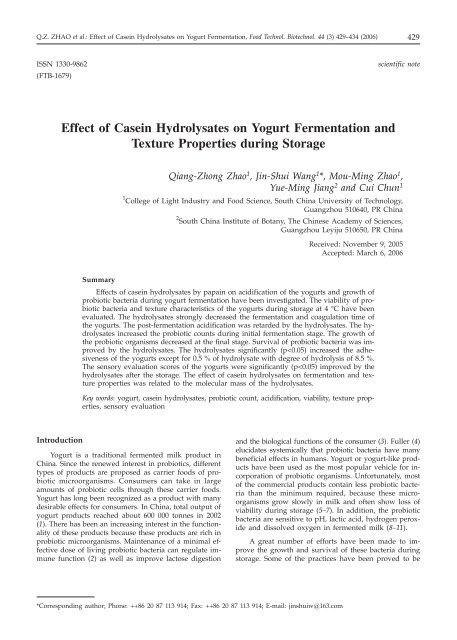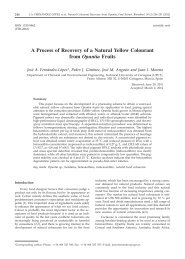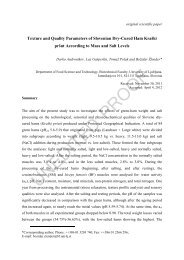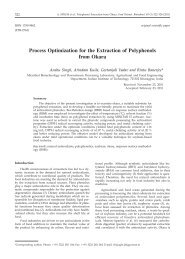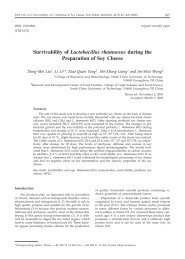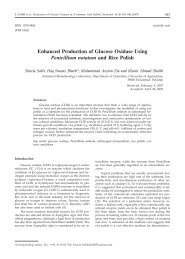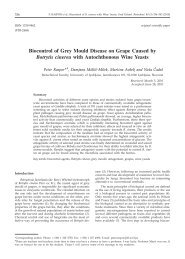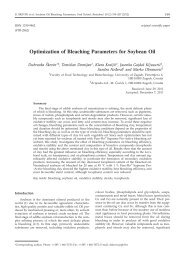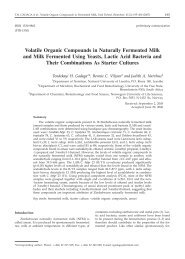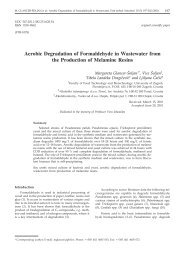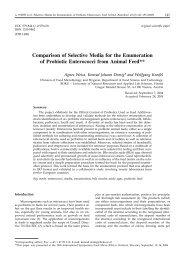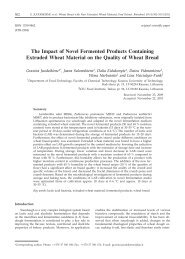Effect of Casein Hydrolysates on Yogurt Fermentation - Food ...
Effect of Casein Hydrolysates on Yogurt Fermentation - Food ...
Effect of Casein Hydrolysates on Yogurt Fermentation - Food ...
You also want an ePaper? Increase the reach of your titles
YUMPU automatically turns print PDFs into web optimized ePapers that Google loves.
Q.Z. ZHAO et al.: <str<strong>on</strong>g>Effect</str<strong>on</strong>g> <str<strong>on</strong>g>of</str<strong>on</strong>g> <str<strong>on</strong>g>Casein</str<strong>on</strong>g> <str<strong>on</strong>g>Hydrolysates</str<strong>on</strong>g> <strong>on</strong> <strong>Yogurt</strong> Fermentati<strong>on</strong>, <strong>Food</strong> Technol. Biotechnol. 44 (3) 429–434 (2006)429ISSN 1330-9862(FTB-1679)scientific note<str<strong>on</strong>g>Effect</str<strong>on</strong>g> <str<strong>on</strong>g>of</str<strong>on</strong>g> <str<strong>on</strong>g>Casein</str<strong>on</strong>g> <str<strong>on</strong>g>Hydrolysates</str<strong>on</strong>g> <strong>on</strong> <strong>Yogurt</strong> Fermentati<strong>on</strong> andTexture Properties during StorageQiang-Zh<strong>on</strong>g Zhao 1 , Jin-Shui Wang 1 *, Mou-Ming Zhao 1 ,Yue-Ming Jiang 2 and Cui Chun 11 College <str<strong>on</strong>g>of</str<strong>on</strong>g> Light Industry and <strong>Food</strong> Science, South China University <str<strong>on</strong>g>of</str<strong>on</strong>g> Technology,Guangzhou 510640, PR China2 South China Institute <str<strong>on</strong>g>of</str<strong>on</strong>g> Botany, The Chinese Academy <str<strong>on</strong>g>of</str<strong>on</strong>g> Sciences,Guangzhou Leyiju 510650, PR ChinaReceived: November 9, 2005Accepted: March 6, 2006Summary<str<strong>on</strong>g>Effect</str<strong>on</strong>g>s <str<strong>on</strong>g>of</str<strong>on</strong>g> casein hydrolysates by papain <strong>on</strong> acidificati<strong>on</strong> <str<strong>on</strong>g>of</str<strong>on</strong>g> the yogurts and growth <str<strong>on</strong>g>of</str<strong>on</strong>g>probiotic bacteria during yogurt fermentati<strong>on</strong> have been investigated. The viability <str<strong>on</strong>g>of</str<strong>on</strong>g> probioticbacteria and texture characteristics <str<strong>on</strong>g>of</str<strong>on</strong>g> the yogurts during storage at 4 °C have beenevaluated. The hydrolysates str<strong>on</strong>gly decreased the fermentati<strong>on</strong> and coagulati<strong>on</strong> time <str<strong>on</strong>g>of</str<strong>on</strong>g>the yogurts. The post-fermentati<strong>on</strong> acidificati<strong>on</strong> was retarded by the hydrolysates. The hydrolysatesincreased the probiotic counts during initial fermentati<strong>on</strong> stage. The growth <str<strong>on</strong>g>of</str<strong>on</strong>g>the probiotic organisms decreased at the final stage. Survival <str<strong>on</strong>g>of</str<strong>on</strong>g> probiotic bacteria was improvedby the hydrolysates. The hydrolysates significantly (p
430 Q.Z. ZHAO et al.: <str<strong>on</strong>g>Effect</str<strong>on</strong>g> <str<strong>on</strong>g>of</str<strong>on</strong>g> <str<strong>on</strong>g>Casein</str<strong>on</strong>g> <str<strong>on</strong>g>Hydrolysates</str<strong>on</strong>g> <strong>on</strong> <strong>Yogurt</strong> Fermentati<strong>on</strong>, <strong>Food</strong> Technol. Biotechnol. 44 (3) 429–434 (2006)able to increase the survival <str<strong>on</strong>g>of</str<strong>on</strong>g> these bacteria in the yogurtproducts. The substances such as oligosaccharides(12), sugar sources (13) and n<strong>on</strong>-protein nitrogen (13,14)can improve the growth <str<strong>on</strong>g>of</str<strong>on</strong>g> probiotic bacteria. Vitamins,dextrin and maltose stimulate the growth <str<strong>on</strong>g>of</str<strong>on</strong>g> bifidobacteriaspecies in milk, while sucrose and ir<strong>on</strong> salts havelittle effect. Ascorbic acid, an oxygen scavenger (7), doesnot improve viability <str<strong>on</strong>g>of</str<strong>on</strong>g> bifidobacteria in yogurt, but itcan be applied to ensure better survival <str<strong>on</strong>g>of</str<strong>on</strong>g> L. acidophilusand B. bifidum in yogurt (15).Some protein hydrolysates enhance the acidificati<strong>on</strong>rate <str<strong>on</strong>g>of</str<strong>on</strong>g> yogurt and reduce the fermentati<strong>on</strong> time (8,16).However, these hydrolysates affect the texture and thephysical properties <str<strong>on</strong>g>of</str<strong>on</strong>g> the yogurt by changing the fermentati<strong>on</strong>time, starter culture metabolism, and interactingwith milk proteins to form the building blocks <str<strong>on</strong>g>of</str<strong>on</strong>g> thegel network. Supplementati<strong>on</strong> <str<strong>on</strong>g>of</str<strong>on</strong>g> milk with a combinati<strong>on</strong><str<strong>on</strong>g>of</str<strong>on</strong>g> casit<strong>on</strong>e, casein hydrolysate and fructose stimulatesthe growth <str<strong>on</strong>g>of</str<strong>on</strong>g> L. acidophilus (8). The probiotic in theyogurt with cysteine is less firm and less viscous thanyogurt without cysteine (17). Milk supplementati<strong>on</strong> withpeptides and amino acids may also increase the viability<str<strong>on</strong>g>of</str<strong>on</strong>g> probiotic organisms (14,18). Milk protein hydrolysatereduces fermentati<strong>on</strong> time and increases the viability <str<strong>on</strong>g>of</str<strong>on</strong>g>two strains <str<strong>on</strong>g>of</str<strong>on</strong>g> probiotic bacteria in milk (19). The yogurtswith casein and whey protein hydrolysates decreasethe complex viscosity and fermentati<strong>on</strong> time, and have amore open and less branched structure (20).In the present study, the effects <str<strong>on</strong>g>of</str<strong>on</strong>g> casein hydrolysateswith three different degrees <str<strong>on</strong>g>of</str<strong>on</strong>g> hydrolysis (DH=8.5,14.6 and 26.7 %) by papain <strong>on</strong> acidificati<strong>on</strong> and probioticcounts in yogurt have been investigated. The viability<str<strong>on</strong>g>of</str<strong>on</strong>g> probiotic bacteria and texture characteristics <str<strong>on</strong>g>of</str<strong>on</strong>g> yogurtsc<strong>on</strong>taining probiotic bacteria, and supplementedwith casein hydrolysates during storage at 4 °C havebeen evaluated.Materials and MethodsStrains and ingredientsThe commercial bacterial strain YC-370 (Streptococcusthermophilus and Lactobacillus delbrueckii ssp. bulgaricus)was used (Chr. Hansen, Guangzhou, China). Thestrain was stored at -40 °C in a c<strong>on</strong>centrate form andthen it was thawed and diluted 10 times in sterilizedskim milk just before inoculati<strong>on</strong>. The food grade enzyme(papain) was provided by Guangzhou EnzymeCo. (Guangzhou, China). Sodium casein was also purchasedfrom Chr. Hansen, Guangzhou, China.<str<strong>on</strong>g>Casein</str<strong>on</strong>g> hydrolysate preparati<strong>on</strong>A fracti<strong>on</strong> <str<strong>on</strong>g>of</str<strong>on</strong>g> 10 % <str<strong>on</strong>g>of</str<strong>on</strong>g> aqueous dispersi<strong>on</strong> <str<strong>on</strong>g>of</str<strong>on</strong>g> sodiumcasein was applied to enzymatic hydrolysis. The enzymatichydrolysis was carried out at 60 °C, c<strong>on</strong>stant pH=6.8with an enzyme to substrate ratio [E/S] <str<strong>on</strong>g>of</str<strong>on</strong>g> 380 U/g. Theenzyme was inactivated by heat treatment at 90 °C for10 min. The resulting mixture was rapidly cooled to ambienttemperature in the ice-water bath and then centrifuged(4000 rpm) for 20 min. The resulting supernatant(hydrolysate) was freeze-dried and then stored for furtherapplicati<strong>on</strong>. The hydrolysates with DH <str<strong>on</strong>g>of</str<strong>on</strong>g> 8.5, 14.6and 26.7 % were used as supplements to yogurt. Thesehydrolysates are expressed as CH1, CH2 and CH3.<strong>Yogurt</strong> preparati<strong>on</strong>Whole powdered milk, sucrose and the hydrolysateswere blended (model JB200-D, Japan). The protein c<strong>on</strong>tentwas standardized to w=5 % by the additi<strong>on</strong> <str<strong>on</strong>g>of</str<strong>on</strong>g> powderedskim milk (Chr. Hansen, Guangzhou, China). Thestandardized milk was supplemented with CH1, CH2and CH3 each at 0, 0.5, 1.0, 1.5 and 2.0 %. After beinghomogenized for 10 min at 20 MPa, it was heated (95°C, 5 min), cooled to 4 °C in an ice-water bath, pouredinto 250-mL flasks and stored for 24 h before testing.Standardized milk that was not supplemented with hydrolysateswas used as the c<strong>on</strong>trol (CK). Standardizedmilk samples were inoculated at the fermentati<strong>on</strong> temperature(42 °C) with 6.31·10 5 CFU/mL <str<strong>on</strong>g>of</str<strong>on</strong>g> bacterial strainYC 370 at inoculati<strong>on</strong> rates <str<strong>on</strong>g>of</str<strong>on</strong>g> 0.005 % (m/V), accordingto the manufacturer’s recommendati<strong>on</strong>. Inoculated milksamples were incubated at 42 °C until pH=4.40. Fermentati<strong>on</strong>was stopped by rapidly cooling the fermentedmilk to 4 °C in an ice-water bath. The cooled yogurt waspoured into 100-mL cups and stored at 4 °C.Chemical analysisC<strong>on</strong>tents <str<strong>on</strong>g>of</str<strong>on</strong>g> total nitrogen and n<strong>on</strong>-protein nitrogenwere measured by the Kjeldhal method (21). A c<strong>on</strong>versi<strong>on</strong>factor <str<strong>on</strong>g>of</str<strong>on</strong>g> 6.2 was used. All measurements were performedin duplicate.Molecular mass distributi<strong>on</strong> <str<strong>on</strong>g>of</str<strong>on</strong>g> the hydrolysatesThe molecular mass distributi<strong>on</strong> <str<strong>on</strong>g>of</str<strong>on</strong>g> the hydrolysateswas determined by Amersham Protein Analytical andPurifying System equipped with Superdex-peptide-10/300-Gl glass column. Eluting soluti<strong>on</strong> was phosphatebuffer 0.25 M (pH=7.2) and flow rate was 0.5 mL/min.Globin III (M r =2512), Globin II (M r =6214), Globin I (M r =8519), Globin I+III (M r =10700), Globin (M r =16949) wereused as standard peptides (Amersham).Acidificati<strong>on</strong>The pH <str<strong>on</strong>g>of</str<strong>on</strong>g> the fermented milk was m<strong>on</strong>itored at17–20 °C by using the Cinac pH meter after calibratingit with fresh pH=4.0 and 7.0 standard buffers. The timetaken for the pH to reach 4.4 was calculated as the fermentati<strong>on</strong>time. Coagulati<strong>on</strong> time expressed as the pHrecorded after 35-day storage period at 4 °C and post--fermentati<strong>on</strong> acidificati<strong>on</strong> were also recorded. This assaywas performed in four replicates <str<strong>on</strong>g>of</str<strong>on</strong>g> each sample.Probiotic countsProbiotic cell numbers during fermentati<strong>on</strong> and afterstorage for 30 days at 4 °C were recorded. Appropristerilewater and subsequently plated in duplicate <strong>on</strong> se-ate diluti<strong>on</strong>s <str<strong>on</strong>g>of</str<strong>on</strong>g> the samples were prepared in 0.1 % (m/V)lective media. Populati<strong>on</strong>s <str<strong>on</strong>g>of</str<strong>on</strong>g> Lactobacillus delbrueckii ssp.bulgaricus were enumerated <strong>on</strong> MRS agar plates at pH==5.4 and incubated at 37 °C for 72 h. Populati<strong>on</strong>s <str<strong>on</strong>g>of</str<strong>on</strong>g> S.thermophilus were enumerated <strong>on</strong> Elliker agar plates aftera 72-hour incubati<strong>on</strong> period at 37 °C.
Q.Z. ZHAO et al.: <str<strong>on</strong>g>Effect</str<strong>on</strong>g> <str<strong>on</strong>g>of</str<strong>on</strong>g> <str<strong>on</strong>g>Casein</str<strong>on</strong>g> <str<strong>on</strong>g>Hydrolysates</str<strong>on</strong>g> <strong>on</strong> <strong>Yogurt</strong> Fermentati<strong>on</strong>, <strong>Food</strong> Technol. Biotechnol. 44 (3) 429–434 (2006)431Texture pr<str<strong>on</strong>g>of</str<strong>on</strong>g>ile analysisTexture pr<str<strong>on</strong>g>of</str<strong>on</strong>g>ile analysis (TPA) was performed usinga TA-XT2i texturometer (Stable Micro Systems, Surrey,UK) to determine the textures <str<strong>on</strong>g>of</str<strong>on</strong>g> the yogurts. The probepenetrated the samples to a depth <str<strong>on</strong>g>of</str<strong>on</strong>g> 15 mm at a speed<str<strong>on</strong>g>of</str<strong>on</strong>g> 1.0 mm/s and the force exerted <strong>on</strong> the probe was automaticallyrecorded. The parameters recorded includehardness, adhesiveness, springiness, cohesiveness, gumminess,chewiness and resilience. Three yogurt sampleswere analyzed at (4±2) °C for each trial and average readingswere taken.Sensory analysisA number <str<strong>on</strong>g>of</str<strong>on</strong>g> 10 to 15 trained panelists who c<strong>on</strong>sumeyogurts regularly in their diets and have previousexperience in taste evaluati<strong>on</strong> were selected to rate sensoryproperties <str<strong>on</strong>g>of</str<strong>on</strong>g> yogurt. Firstly, the panelists weretrained in 2-hour sessi<strong>on</strong>s prior to evaluati<strong>on</strong> to be familiarwith the attributes and scaling procedures <str<strong>on</strong>g>of</str<strong>on</strong>g> yogurtsamples under study. <strong>Yogurt</strong> samples were organolepticallyexamined according to the method modifiedfrom Bodyfelt et al. (22) with maximum scores <str<strong>on</strong>g>of</str<strong>on</strong>g> 10, 5,and 5 for flavour; body and texture; and appearance andcolour, respectively, the highest number indicating extremeliking and the lowest extreme dislike. Panelistswere also asked to note any acetaldehyde, bitter, cooked,foreign, acid (too high and too low), oxidized or unnaturalflavour, and other perceived attributes for flavour;gel-like, grainy, ropy, too firm, too weak, and other perceivedattributes for body and texture; and whey-<str<strong>on</strong>g>of</str<strong>on</strong>g>f,lumpy, shrunken, dark colour, partial colour, and otherperceived attributes for appearance and colour. All yogurtsamples (in 100-mL yogurt cups) were coded withthree-digit random numbers and presented to panelists<strong>on</strong> a tray in individual booths. Order <str<strong>on</strong>g>of</str<strong>on</strong>g> serving wascompletely randomized. Panelists were instructed tocleanse their palate with plain crackers and water beforetasting each sample. Panelists evaluated all yogurt samplesafter storage for 1, 7, and 14 days at 4 °C.Statistical analysisUnless otherwise stated, all the tests were performedin triplicate and data were averaged. Standard deviati<strong>on</strong>was also calculated. Duncan’s multiple-range test (23) wasused to evaluate significant difference (p
432 Q.Z. ZHAO et al.: <str<strong>on</strong>g>Effect</str<strong>on</strong>g> <str<strong>on</strong>g>of</str<strong>on</strong>g> <str<strong>on</strong>g>Casein</str<strong>on</strong>g> <str<strong>on</strong>g>Hydrolysates</str<strong>on</strong>g> <strong>on</strong> <strong>Yogurt</strong> Fermentati<strong>on</strong>, <strong>Food</strong> Technol. Biotechnol. 44 (3) 429–434 (2006)Coagulati<strong>on</strong> time/h4.54.03.53.02.52.01.51.00.50CH1 CH2 CH3<str<strong>on</strong>g>Casein</str<strong>on</strong>g> hydrolysatesFig. 2. Coagulati<strong>on</strong> time <str<strong>on</strong>g>of</str<strong>on</strong>g> yogurt with added casein hydrolysates.CH1, CH2, CH3 and the columns represent the same as inFig. 1Probiotic counts/(log CFU/mL)9.08.58.07.57.06.56.0pH4.454.404.354.304.254.204.154.104.054.003.95CH1CH2<str<strong>on</strong>g>Hydrolysates</str<strong>on</strong>g>CH3Fig. 3. Change in pH <str<strong>on</strong>g>of</str<strong>on</strong>g> yogurts with added hydrolysates afterstorage for 30 days. CH1, CH2, CH3 and the columns representthe same as in Fig. 1riod <str<strong>on</strong>g>of</str<strong>on</strong>g> 30 days at low temperature. Post-fermentati<strong>on</strong>acidificati<strong>on</strong> had a negative effect <strong>on</strong> the quality, andshortened the shelf life. It is closely associated with thepersistent metabolic activity <str<strong>on</strong>g>of</str<strong>on</strong>g> lactobacilli during coolingat4°C(24).Decrease in post-fermentati<strong>on</strong> acidificati<strong>on</strong>was favourable for sensory improvement and c<strong>on</strong>sumers’preference.5.50 1 2 3 4 5Fermentati<strong>on</strong> time/hFig. 4. <str<strong>on</strong>g>Effect</str<strong>on</strong>g> <str<strong>on</strong>g>of</str<strong>on</strong>g> the supplement <str<strong>on</strong>g>of</str<strong>on</strong>g> hydrolysates <strong>on</strong> growth <str<strong>on</strong>g>of</str<strong>on</strong>g> probioticbacteria in yogurt. CK, CH1 (0.5 %), CH1 (1.5 %), CH2 (0.5 %), ´ CH2 (1.5 %), + CH3 (0.5 %), CH3 (1.5 %). CH1,CH2 and CH3 are the same as in Fig. 1Change in growth and viability <str<strong>on</strong>g>of</str<strong>on</strong>g> probiotic bacteriaduring fermentati<strong>on</strong> and storageThe growth <str<strong>on</strong>g>of</str<strong>on</strong>g> probiotic organisms during fermentati<strong>on</strong>is presented in Fig. 4. The hydrolysates increasedthe probiotic counts at initial stage compared to the c<strong>on</strong>trol.It indicated that the hydrolysates enhanced thegrowth <str<strong>on</strong>g>of</str<strong>on</strong>g> probiotic organisms. However, the growth <str<strong>on</strong>g>of</str<strong>on</strong>g>the probiotic organisms decreased at the final stage whenthe hydrolysates were added. The growth <str<strong>on</strong>g>of</str<strong>on</strong>g> these bacteriadecreased with the increase in the additi<strong>on</strong> <str<strong>on</strong>g>of</str<strong>on</strong>g> hydrolysates.This was related to the decrease in fermentati<strong>on</strong>time.L. acidophilus and B. bifidum have to retain viabilityand activity in the food system to meet the requirementsfor c<strong>on</strong>sumpti<strong>on</strong> (25). Viability <str<strong>on</strong>g>of</str<strong>on</strong>g> probiotic bacteria inproducts during l<strong>on</strong>g shelf life at refrigerati<strong>on</strong> temperatureis generally unsatisfactory (8,26) because the lowsurvival <str<strong>on</strong>g>of</str<strong>on</strong>g> probiotic organisms in the fermented dairyproducts is the greatest obstacle encountered in processing,and especially during storage (27).The counts <str<strong>on</strong>g>of</str<strong>on</strong>g> probiotic bacteria in yogurts decreasethroughout storage. However, decline in the counts <str<strong>on</strong>g>of</str<strong>on</strong>g>probiotic organisms during storage can be retarded byhydrolysates (Fig. 5). After 30 days <str<strong>on</strong>g>of</str<strong>on</strong>g> storage, the yogurtswith the hydrolysates have more probiotic bacteriathan the c<strong>on</strong>trol. The yogurt with 1.5 % <str<strong>on</strong>g>of</str<strong>on</strong>g> CH3 hasabout 3-fold more probiotic bacteria than the c<strong>on</strong>trol.The hydrolysates significantly (p
Q.Z. ZHAO et al.: <str<strong>on</strong>g>Effect</str<strong>on</strong>g> <str<strong>on</strong>g>of</str<strong>on</strong>g> <str<strong>on</strong>g>Casein</str<strong>on</strong>g> <str<strong>on</strong>g>Hydrolysates</str<strong>on</strong>g> <strong>on</strong> <strong>Yogurt</strong> Fermentati<strong>on</strong>, <strong>Food</strong> Technol. Biotechnol. 44 (3) 429–434 (2006)433Texture characteristicsTable 1 shows changes in texture properties <str<strong>on</strong>g>of</str<strong>on</strong>g> theyogurts determined by TA-XT2i texturometer. The treatmentsand c<strong>on</strong>trol had no significant (p
434 Q.Z. ZHAO et al.: <str<strong>on</strong>g>Effect</str<strong>on</strong>g> <str<strong>on</strong>g>of</str<strong>on</strong>g> <str<strong>on</strong>g>Casein</str<strong>on</strong>g> <str<strong>on</strong>g>Hydrolysates</str<strong>on</strong>g> <strong>on</strong> <strong>Yogurt</strong> Fermentati<strong>on</strong>, <strong>Food</strong> Technol. Biotechnol. 44 (3) 429–434 (2006)scores significantly (p


